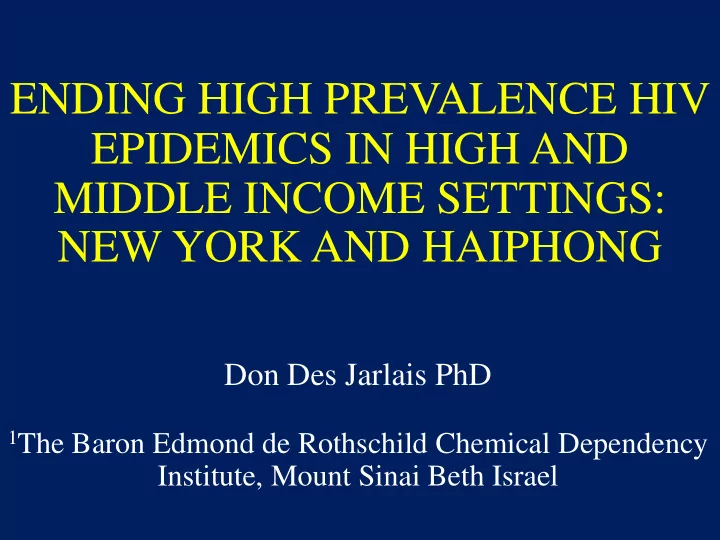

ENDING HIGH PREVALENCE HIV EPIDEMICS IN HIGH AND MIDDLE INCOME SETTINGS: NEW YORK AND HAIPHONG Don Des Jarlais PhD 1 The Baron Edmond de Rothschild Chemical Dependency Institute, Mount Sinai Beth Israel
STUDY TEAM: USA : Don C Des Jarlais , Kamyar Arasteh, Jonathan Feelemyer, Courtney McKnight Vietnam : Huong Duong Thi, Oanh Khuat Thi Hai, Khuê Pham Minh, Giang Hoang Thi, Thanh Nham Thi Tuyet, Vinh Vu Hai, Le Minh Giang France : Nicolas Nagot, Didier Laureillard, Marianne Peries, Laurent Michel, Marie Jauffret-Roustide, Jean- Pierre Moles, Catherine Quillet, Roselyne Vallo, Delphine Rapoud
THE HIGH PREVALENCE PROBLEM • Many PWID who are HIV seropositive, capable of transmitting the virus • Many PWID who are HIV seronegative, susceptible to acquiring the virus • Impossible to eliminate injecting risk behavior
THE HIGH PREVALENCE PROBLEM • In absence of comprehensive prevention and treatment, incidence rates of 4/100 PY to 6/100 PY are typical
Combined HIV Prevention and Care for PWID • Syringe Service Programs (SSP) — Exchange and Legal Pharmacy Sales • Medication Assisted Treatment (MAT) — Methadone and/or Buprenorphine for Heroin/opioid use disorders • Antiretroviral Treatment (ART) — for persons who are HIV seropositive
Combined HIV Prevention and Care for PWID HIGH COVERAGE • Syringe Service Programs (SSP) — 50 to 200 syringes per PWID per year • Medication Assisted Treatment (MAT) — 50% of heroin users on treatment • Antiretroviral Treatment (ART) — 90-90-90 goals (72% of HIV seropositives at viral suppression)
ENDING AN HIV EPIDEMIC AMONG PWID • NOT COMPLETE ABSENCE OF HIV INFECTIONS • PREVELANCE OF HIV SEROPOSITIVE PWID: < 5% • HIV INCIDENCE AMONG PWID: > 0.5/100 PY
SPECIAL ISSUES IN LOW/MIDDLE INCOME COUNTRIES • LIMITED PUBLIC HEALTH DATA • LACK OF RESOURCES: particularly trained staff, withdrawal of international donors • INTENSE STIGMATIZATION OF INJECTNG DRUG USE • INTENSE STIGMATIZATION OF HIV INFECTION
RESEARCH METHODS • NEW YORK: serial cross sectional surveys of PWID entering treatment for prevalence and ART, repeat participants and HIV surveillance for incidence • HAI PHONG: serial large scale community surveys for prevalence and ART, repeat participants and cohort studies for incidence
LOCAL SITUATION IN NEW YORK MAT since late 1960s HIV epidemic in late 1970s, 50+% in early 1980s Needle/syringe exchange implemented in 1993 Antiretrovial treatment for PWID in early 2000s
LOCAL SITUATION IN HAIPHONG Haiphong has led movement towards evidence based HIV prevention in Vietnam High prevalence of HIV among PWID, as high as 66% in 2006 Needle/syringe exchange implemented in 2005 Methadone pilot programs begun in 2008: 3,200 patients currently Antiretrovial treatment offered free for all HIV+ persons in 2014
ESTIMATING POPULATION OF PWID IN HAIPHONG Good estimates needed for proper allocation of scarce resources Good estimates needed to assess coverage
METHODS: POPULATION SAMPLE A 2014 RDS survey served as one capture, Distribution of 600 distinctively marked cigarette lighters at drug use “ hotspots ” in 2016 served as another “ capture A 2016 survey using RDS methods was conducted 1 week after lighter distribution served as “ recapture ” for both captures
METHODS: POPULATION SAMPLE Fingerprint reader was used to avoid multiple participation in 2014 and 2016 surveys Fingerprint reader then used to identify persons who participated in both surveys--recaptured Participants in 2016 survey were asked to show (or describe) their lighters--recaptured
FORMULAS: POPULATION SAMPLE
RESULTS 1385 participants were included in the “ recapture ” survey Characteristics of 2016 sample: 94% male, median age 39; 100% injected heroin, HIV prevalence was 30%, HCV prevalence 71% 144 of the 603 participants in the 2014 survey and 152 of the 600 PWID who had received lighters were “ recaptured ” in the 2016 survey
RECRUITMENT BY WEEK
2014 RECAPTURED PWID BY WEEK
TOKENS RECEIVED BY WEEK
CONTEXTUAL ISSUES • Turnover in the PWID population between 2014 to 2016 reduces possible recapture leading to overestimation of population size • Best estimate: 5% turnover for each of 2 years between 2014 and 2016 surveys
CONTEXTAUL ISSUES Police suppression of drug distribution “ hotspots ” during second half of the 2016 survey study Recapture of persons with lighters fell from 15% in first half of study to > 4% in second half of 2016 survey Best assumption: recapture of persons with lighters would have been 13% without police suppression of hotspots
RESULTS: POPULATION ESTIMATE Our best estimate from the 2014 survey to 2016 survey recapture was 5220 (95% CI: 4568-5872) Our best estimate of the active population size from the lighter recapture was 4617 (95% CI: 4090-5143) Combined rounded best estimate of the active PWID population in Hai Phong is 5000, range 4000-6000 Plus 4000 in methadone treatment
ENDING HIV EPIDEMICS AMONG PWID • PREVALENCE OF HIV SEROPOSITIVES NOT AT VIRAL SUPPRESSION, TARGET < 5% • NEW YORK: 2% • HAI PHONG: 7.5%
ENDING HIV EPIDEMICS AMONG PWID • HIV INCIDENCE, TARGET < 0.5/100 PY • NEW YORK: 0/100 cohort study, 0.04/100 PY by newly identified HIV seropositives, “ Sentinental Event ” study • HAI PHONG: < 0.5/100 PY by repeat survey participants and cohort studies
ISSUES FOR NEW YORK CITY Opioid/heroin/fentanyl epidemic, many new users Overdose deaths, fentanyl and derivatives Need for HCV treatment and prevention
ISSUES FOR HAI PHONG Police suppression of public drug use activity Reduction of PEPFAR funding, transition of ART clinics to regular health care, regular social health insurance “ Renovation ” plan to phase out compulsory center drug treatment to evidence based community treatment (methadone) may be stalling, methamphetamine use increasing, political concern over use among methadone patients Mental health, including suicide Need for HCV treatment
ISSUES FOR HAI PHONG Police suppression of public drug use activity Reduction of PEPFAR funding, transition of ART clinics to regular health care, regular social health insurance “ Renovation ” plan to phase out compulsory center drug treatment to evidence based community treatment (methadone) may be stalling, methamphetamine use increasing, political concern over use among methadone patients Mental health, including suicide Need for HCV treatment and prevention
Recommend
More recommend